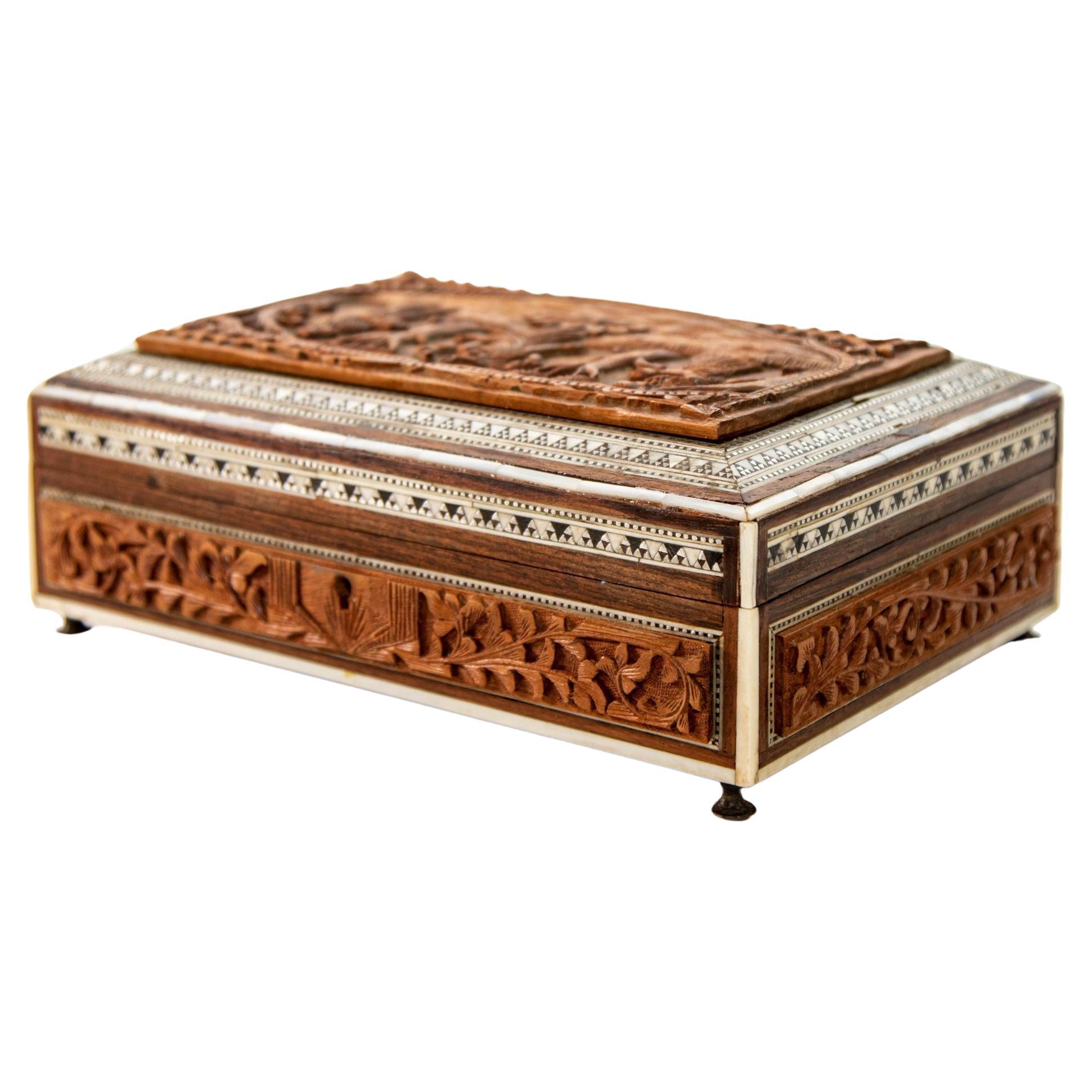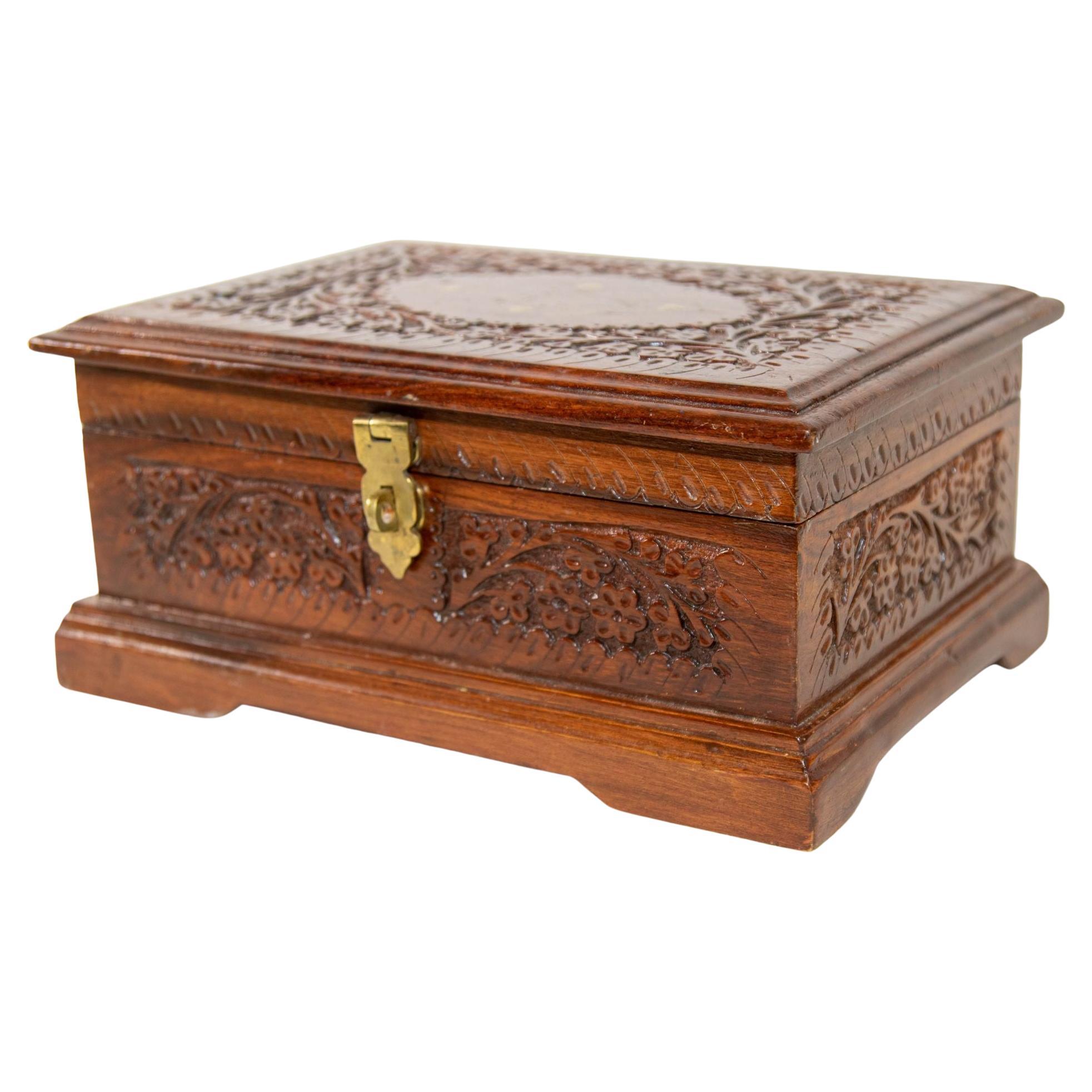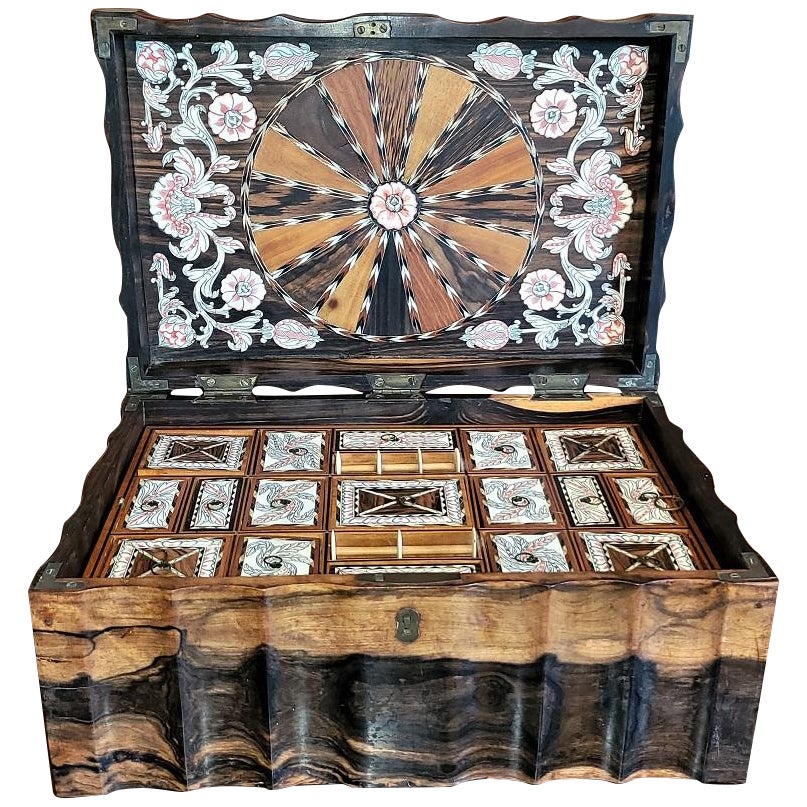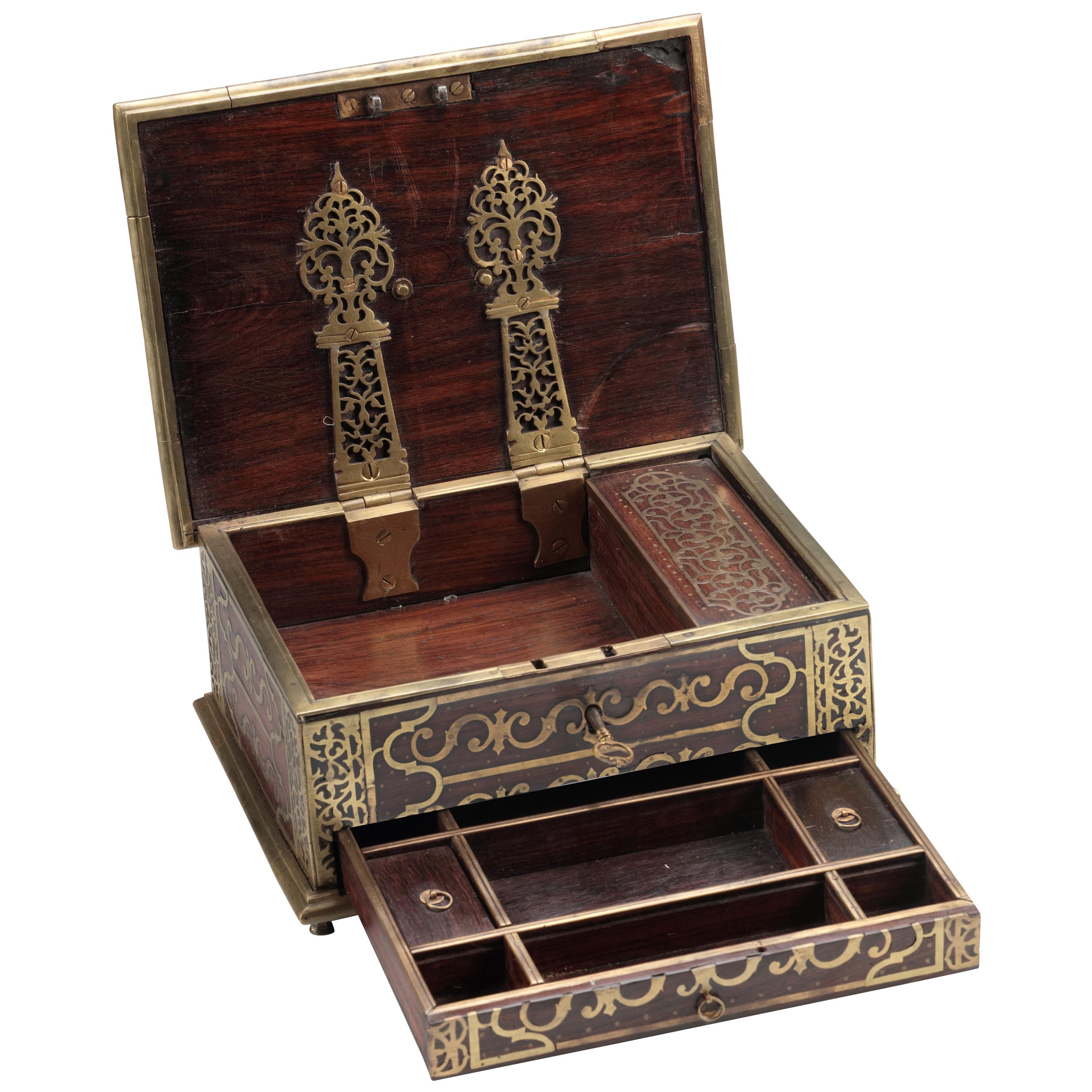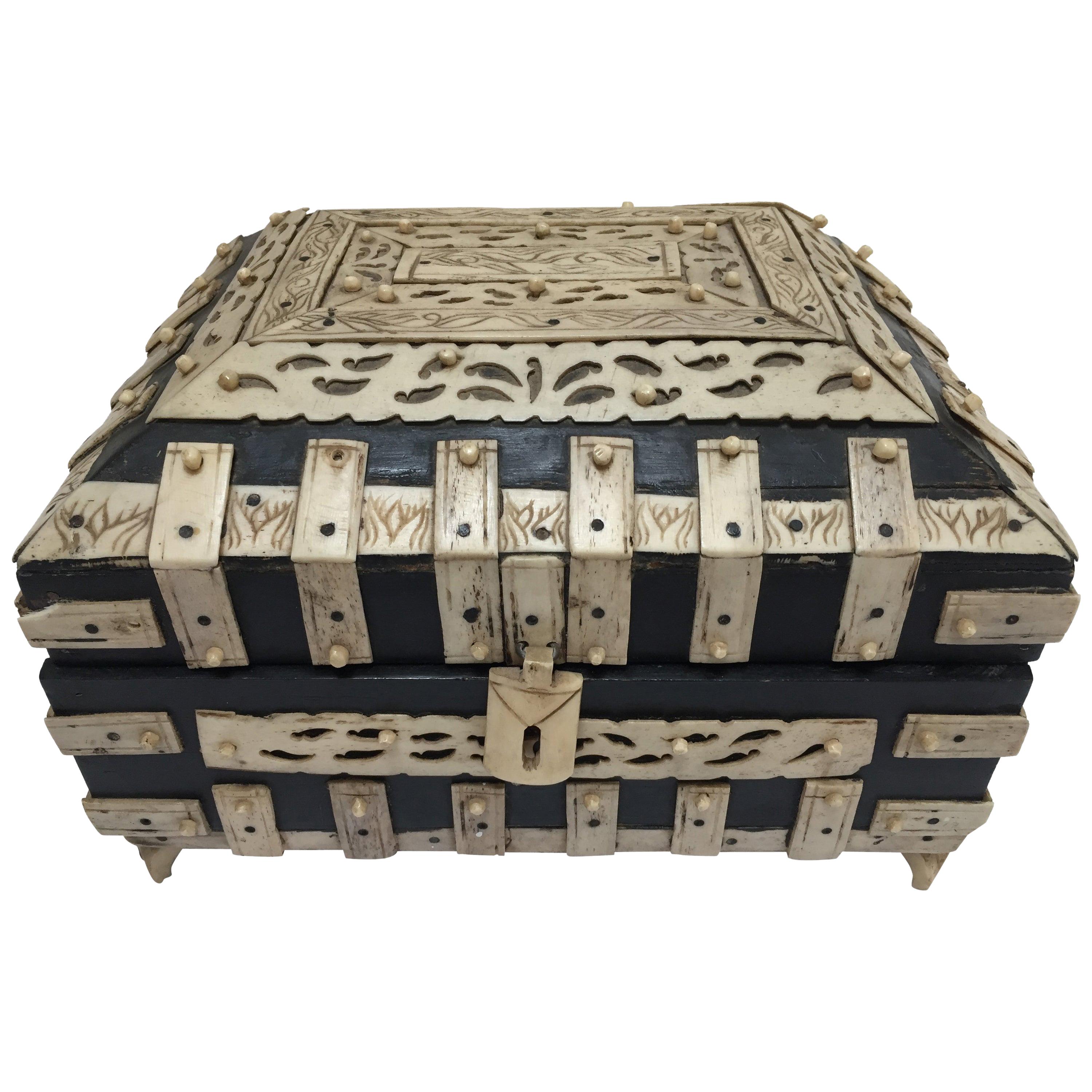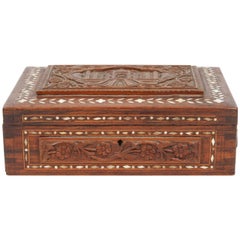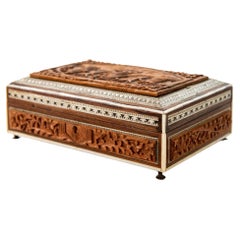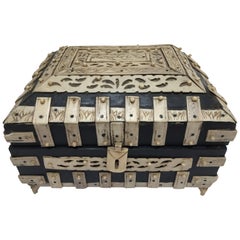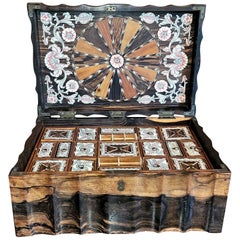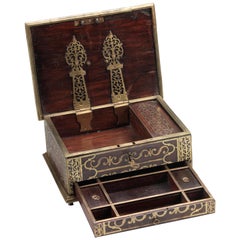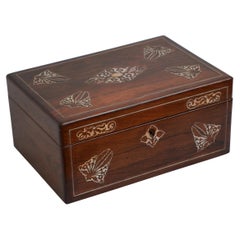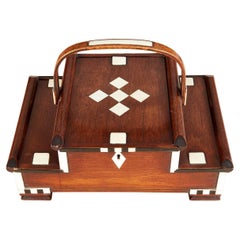Items Similar to Anglo-Indian Footed Box with Lidded Compartments, 19th Century
Want more images or videos?
Request additional images or videos from the seller
1 of 17
Anglo-Indian Footed Box with Lidded Compartments, 19th Century
$1,500
£1,167.85
€1,328.18
CA$2,158.14
A$2,370.62
CHF 1,238.90
MX$28,271.65
NOK 15,687.86
SEK 14,614.56
DKK 9,924.80
About the Item
19th century Anglo-Indian wooden box fitted with various compartments finely hand carved.
The top is finely hand carved with the Taj Mahal.
The interior with removable hand carved nine-lidded compartments, the front cover has a mirror, the whole exhibiting very fine workmanship.
This fine late Victorian Anglo-Indian box from India is in great condition for it age.
A beautiful example of an Anglo-Indian fine art box raised on brass feet.
Mughal style box with wonderful condition throughout, circa 1870.
History of the Anglo-Indian Boxes
Beginning in the early part of the 18th century, Indian artisans made what came to be known as Anglo-Indian boxes for the English residents living in India, who eventually brought or sent them back to England. At the beginning of the 19th century, India began exporting these boxes commercially, although not in any significant numbers until the 1850s. People valued them so highly that manufacturers of tins copied the designs on them in the late 19th and early 20th century.
Anglo-Indian boxes fall into four groups: Rosewood or ebony boxes inlaid with ivory;
English traders discovered the rich woods and intricate workmanship of Indian artisans, so colonial government officials began to recognize the work of the Indian artists and craftsmen as a source for satisfying the need for furniture and boxes, which would both serve to enhance English households in India. This gave rise to the cabinetmaking workshops in Vizagapatam between Calcutta and Madras.
Craftsmen made the first boxes to be decorated with Sadeli mosaic incised to give further definition to the decoration, directly inlaid into the wood. The shape of the early boxes was either sloping at the front with a flatter section at the back, reminiscent of English writing slopes, or rectangular. Artisans inlaid the borders with stylized floral scrolls and the centers with a single floral motif following a circular or oval symmetrical or asymmetrical pattern.
- Dimensions:Height: 3.25 in (8.26 cm)Width: 9 in (22.86 cm)Depth: 6.5 in (16.51 cm)
- Style:Anglo-Indian (In the Style Of)
- Materials and Techniques:
- Place of Origin:
- Period:
- Date of Manufacture:1870
- Condition:Wear consistent with age and use. Minor losses.
- Seller Location:Moreno Valley, CA
- Reference Number:Seller: ANG7201stDibs: LU906819801962
About the Seller
5.0
Platinum Seller
Premium sellers with a 4.7+ rating and 24-hour response times
1stDibs seller since 2011
3,184 sales on 1stDibs
Typical response time: 1 hour
- ShippingRetrieving quote...Shipping from: Moreno Valley, CA
- Return Policy
More From This Seller
View All19th Century Anglo-Indian Mughal Box
Located in Moreno Valley, CA
19th century Anglo-Indian Mughal wood box, inlaid and hand carved with the Taj Mahal and some flowers all around.
Jewelry box, Anglo-Raj box from India in great condition.
Nice Mughal Bombay Box...
Category
Antique Late 19th Century Indian Anglo Raj Decorative Boxes
Materials
Sandalwood
Antique Anglo-Indian Vizagapatam Jewelry Inlaid Sadeli Footed Box
Located in Moreno Valley, CA
Antique 19th century Anglo-Indian jewelry, trinket footed box, inlay with ebony, mosaic marquetry Sadeli work and a carved Hindu scene on top.
The box case is made from sandalwood wi...
Category
Early 20th Century Indian Anglo-Indian Decorative Boxes
Materials
Bone, Mother-of-Pearl, Wood
Mid 20th Century Anglo Indian Carved Wood Jewelry Box Kashmir India
Located in Moreno Valley, CA
Vintage hand carved wood jewelry trinket storage box with brass inlaid.
Hand-carved large wooden Anglo-Raj jewelry box. Found in Kashmir, India.
Mi...
Category
Mid-20th Century Indian Anglo-Indian Jewelry Boxes
Materials
Brass
Anglo-Indian Vizagapatam Bombay Mughal Style Footed Box With Bone Overlay
Located in Moreno Valley, CA
Nice and unusual Indian Mughal style large decorative box, filigree and carved horn.
Anglo-Indian footed domed box with exceptional engraved details throughout with filigree and carved veneered bone plaques with arabesque carving.
Vizagapatam, late 19th century.
History of the Anglo-Indian Boxes
Beginning in the early part of the 18th century, Indian artisans made what came to be known as Anglo-Indian boxes for the English residents living in India, who eventually brought or sent them back to England. At the beginning of the 19th century, India began exporting these boxes commercially, although not in any significant numbers until the 1850s. People valued them so highly that manufacturers of tins copied the designs on them in the late 19th and early 20th century.
Anglo-Indian boxes fall into four groups: Rosewood or ebony boxes inlaid;
sandalwood boxes veneered; sandalwood boxes covered with Sadeli mosaic; and carved boxes often combined with Sadeli mosaic/
The first two categories came from Vizagapatam in East India while the last two came from Bombay in West India.
English traders discovered the rich woods and intricate workmanship of Indian artisans, so colonial government officials began to recognize the work of the Indian artists and craftsmen as a source for satisfying the need for furniture and boxes, which would both serve to enhance English households in India. This gave rise to the cabinetmaking workshops in Vizagapatam between Calcutta and Madras.
Craftsmen made the first boxes to be decorated with Sadeli mosaic of rosewood or ebony, incised to give further definition to the decoration, directly inlaid into the wood. The shape of the early boxes was either sloping at the front with a flatter section at the back, reminiscent of English writing slopes, or rectangular. Artisans inlaid the borders with stylized floral scrolls and the centers with a single floral motif following a circular or oval symmetrical or asymmetrical pattern. The edging was ornamental and protective, both helped protect the end grain against the weather.
Made in Vizagapatam, situated on the south east coast of India, near Madras
These exotic boxes...
Category
Antique Late 19th Century Indian Anglo Raj Decorative Boxes
Materials
Wood
Antique 19th c. Decorative Anglo-Indian Overlay Footed Box with Engraved Bone
By Rajhastani
Located in Moreno Valley, CA
Nice and unusual Jewelry decorative box with filigree bone overlaid decoration.
Large Anglo-Indian footed domed box with exceptional engraved bone de...
Category
Antique Late 19th Century Indian Anglo Raj Decorative Boxes
Materials
Wood
19th Century Anglo-Indian Sadeli Mosaic Jewelry Box with Lidded Compartments
Located in Moreno Valley, CA
19th century Anglo-Indian sandal wood box, Sadeli mosaic box fitted with various compartments finely hand-carved with the Taj Mahal.
Of sarcophagus form ...
Category
Antique Late 19th Century Indian Anglo-Indian Decorative Boxes
Materials
Sandalwood
You May Also Like
19C Anglo Ceylonese Sewing Box of Museum Quality
Located in Dallas, TX
Presenting an absolutely stunning 19c Anglo Ceylonese sewing box of museum quality.
Made in Ceylon (now Sri Lanka) circa 1860, this is one of the finest sewing boxes of it’s kind that we have ever seen!
The box is made from coromandel wood (an exotic hardwood found in Ceylon) and has a serpentine edging all over the front, back and sides.
Very often the lids/tops of these boxes suffer cracks due to shrinkage but this one is near perfect with no crack in the lid/top. There is some evidence of natural shrinkage but that is around the edges of the lid/top.
It is when you open this box that it reveals it’s true beauty, quality and treasure !
The inside of the lid/top is heavily and beautifully decorated with inlaid bone in scrolling floral patterns which have then been hand painted with red and black ‘lac’ ink. The central medallion is a circle of inlaid specimen exotic hardwoods radiating towards a central bone and hand painted flower. The circle is edged in bone, wood and silver chevrons.
What makes this box Exceptionally rare is that it contains 3 lift out base sections. Normally, there would be a maximum of 2.
The first tray/section is clearly for the purposes ancillary to sewing with a pair of sections with bone spools for thread etc. There are 17 other lidded compartments with each one highly decorated using hand painted bone and specimen woods to replicate tortoiseshell.
The first tray lifts out to reveal a second removeable tray which is made up of a pair of open sections and 8 specimen wood lidded sections each with chevron banding.
The third tray is a smaller tray underneath with 14 lidded compartments each with hand painted bone and specimen wood inlaid lids again, replicating the look of tortoiseshell. Again they are banded with a chevron border.
This is a museum quality piece !
It is in fantastic condition for it’s age with the minor shrinkage to the edges of the lid/top, some finger pulls missing and some very minor cracks to the tray lids and bases but nothing that in any way detracts from the piece. No key.
Dimensions: Closed the box is 16.75 inches wide, 11.25 inches deep and 7.5 inches high
Fully open the box is 16.5 inches high, 16.75 inches wide and 11.4 inches deep
Anglo-Indian and ceylonese boxes: Anglo Indian boxes were made in India for the English residents from the early part of the 18th century. They were brought back or sent back to England usually by the people who had commissioned them. From the beginning of the nineteenth century they were imported more commercially, although not in any significant numbers until the middle decades. They were very highly valued, especially the early ones, to the extent that the designs were copied on late 19th and early 20th century tins.
Anglo-Indian boxes normally consist of 3 main types:-
(1) Most of the best and highest quality Anglo-Indian boxes in the 18th and 19th centuries were made in Vizagapatam, India, renowned for its exquisite craftsmanship in using ivory and tortoiseshell and lac decoration. These are referred to as ‘Vizagapatam Boxes...
Category
Antique Mid-19th Century Sri Lankan Anglo-Indian Decorative Boxes
Materials
Silver
Colonial Islamic Arabian Market Jewelry Box, 18th Century, India/Malabar Coast
Located in Amsterdam, NL
AN INDIAN ROSEWOOD AND EBONY BRASS MOUNTED BOX FOR THE ISLAMIC MARKET
Malabar Coast, 18th century
With a large drawer with several compartm...
Category
Antique 18th Century Indian Islamic Jewelry Boxes
Materials
Brass
English Early Victorian Jewellery Box with Tray
Located in High Peak, GB
P080 An elegant antique early Victorian goncalo alves sewing box or jewellery box with beautifully inlaid front and hinged top enclosing new relined interior with lift up tray. This ...
Category
Antique 19th Century English Early Victorian Cigar Boxes and Humidors
Materials
Wood
Exquisite 19th c. Luxury Compartmented Ceylonese Sailor's Box
Located in Greenwich, CT
An exquisite 19th century luxury sailor's box in sandalwood with dramatically contrasting bone and ebony geometric decoration and string inlay having raised center tier with sliding ...
Category
Antique Late 19th Century Sri Lankan Anglo-Indian Decorative Boxes
Materials
Sandalwood
Anglo Indian Inlaid Work Box
Located in Tampa, FL
An anglo Indian workbox made of ebony. The tray lifts up from the box on the lid which is also inlaid in ivory and ebony and has a bone round disc that is signed New Bedford 1810. Th...
Category
Antique 1810s Indian Decorative Boxes
Materials
Bone, Ivory, Ebony
Small Antique Apprentice Chest, Anglo-Indian, Colonial Keepsake Box, Victorian
Located in Hele, Devon, GB
This is a small antique apprentice-piece chest. An Anglo-Indian, carved teak Colonial keepsake box, dating to the late Victorian period, circa 1880....
Category
Antique Late 19th Century Indian Late Victorian Decorative Boxes
Materials
Teak
More Ways To Browse
Anglo Indian Hand Carved
Antique Rosewood Box
Indian Inlay
Antique Boxes India
Indian Inlay Furniture
Antique Indian Box
Anglo Indian Inlay
Anglo Indian Boxes
Antique Writing Slope Box Writing Slopes
Footed Box
Ivory Box
Antique Sandalwood
Ivory Inlaid
Carved Indian Boxes
Antique Ivory Box
Ivory Boxes Antique
Oval Wooden Mirror Hand Carved
Mughal Box

